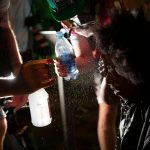Deceptively known as “less-lethal,” these weapons can in fact cause severe injuries and even death when used with excessive force. Physicians for Human Rights has worked extensively on the health impacts of these weapons and has issued the following guidance to help people seeking to exercise their right to protest prepare for, protect against, and treat tear gas and other chemical irritant (e.g., pepper spray) exposure.
What to wear to protect yourself against tear gas and other chemical agents when protesting:
- Facemask. Scarves or bandanas large enough to cover your face from nose to chin can serve as substitutes.
- Shatter-resistant eye protection (e.g. shatter-resistant sunglasses, swim goggles, or a gas mask)
- Clothing covering all your skin as much as possible
- Comfortable, closed, protective shoes that you can run in
- AVOID wearing contact lenses, which can trap irritating chemicals, such as tear gas powder, underneath. If you do wear contacts lenses, keep a full facial gas mask or goggles on at all times.
- AVOID wearing makeup such as eyeliner, for the same reason.
What to bring to a protest:
- Water in your own plastic bottle with a squirt top (to drink and to wash off your skin or eyes)
- A backpack or a drawstring bag – rather than an over-the-shoulder or a cross-body bag – in case you need to run
- Identification and/or emergency contact information (consider writing this on your skin)
- Cash for food and transportation or cash bail, in case you are arrested. Check how much bail is in your location.
- Inhaler, epipen, and several days of prescription medication, in case you are arrested
- A medical alert bracelet or information about any chronic medical conditions or allergies
- A change of clothes, in case you are exposed to chemical irritants
How to protect yourself against tear gas and other chemical irritants:
Agent CS, the most commonly used form of tear gas, is a crystalline powder that is converted into a fine spray and propelled from a grenade or canister by a small pyrotechnic explosion. Agent OC, commonly known as pepper spray, is essentially a highly concentrated form of hot pepper. Though tear gas was classified as a chemical weapon in 1993 and banned from use in international warfare, law enforcement officers are still allowed to use it on civilians in the United States. Some localities are starting to ban use of these chemicals for crowd control by police in the wake of Black Lives Matter protests and their violent disruptions.
When a tear gas canister explodes, CS powder sprays into the air and adheres to any moisture it can find, including the tears in your eyes, the sweat on your skin, the grease in your hair, and the saliva and mucus that cover your mouth and airways.
Symptoms of tear gas exposure can include the following, according to the CDC:
- Eyes: Excessive tearing, redness, burning, blurred vision
- Skin: Burns and rash
- Mouth: Burning, irritation, drooling, trouble swallowing
- Nose: Running, burning, and swelling
- Lungs: Chest tightness, shortness of breath, wheezing, coughing, choking sensation
- Stomach: Nausea and vomiting
What to do if you’re exposed to tear gas or other chemical irritants:
What to do immediately:
- Get out of the cloud of tear gas and away from the general area as soon as you can. Seek high ground, as most forms of tear gas are heavy; the closer you are to the ground, the higher the concentration of gas.
- Walk, don’t run. Running may cause you to breath more heavily, filling your lungs with more tear gas. Try to keep your breathing even.
- If your eyes have been exposed and are burning or blurry, flush them with water immediately. Try not to touch your eyes, nose, or mouth. Use water from your water bottle to flush. If you can find an open drinking fountain or sink in a public restroom, flush your eyes with water for 10 to 15 minutes.
- There is no evidence that baking soda or milk is better than cool water alone. There is one small randomized controlled trial that found that baby shampoo is no better than water. Using baby wipes or makeup wipes if water is not immediately available may cause increased irritation.
- If possible, and you are not affected yourself, help others by moving them to a clean and ventilated area.
- Do not try to remove the tear gas canisters, as doing so may put you at an increased risk for further harm and injury.
How to further get rid of the chemical irritant:
- Change your clothes as soon as possible. Rinse your body as soon as you get to a location with a shower. Take off your shoes outside your home to keep them from bringing any powder indoors.
- Shed all the clothes you were wearing and hang them in an open, ventilated area for at least 48 hours before washing them. If you are not able to keep them in an open place, story them in a sealed bag until they are ready to be washed. Do not mix them with uncontaminated garments, as CS powder can be active for as long as five days after being released.
- Take a cold shower for at least 20 minutes to prevent the chemicals from irritating your skin any further. Do your best not to breathe in more tear gas during the shower, and keep your eyes closed. Wash your hair especially well.
- If you’re still having symptoms 30 minutes or so after getting all the agents off, are having eye or lung issues, or are at all concerned about your exposure, seek medical care.
What to do if your rights have been violated:
- Review “Know Your Rights” documents before heading out to a protest, such as this ACLU guide.
- If your rights are violated by law enforcements officers, when you can, write down everything you remember from the scene, including the officers’ badge and patrol car numbers.
- Get contact information for witnesses.
- Take photographs of any injuries. Get medical treatment right away if you need it and ask for a copy of any medical records.
Resources:
- Physicians for Human Rights: “Lethal in Disguise: The Health Consequences of Crowd-Control Weapons”
- Physicians for Human Rights: Crowd-control Weapons Fact Sheets



